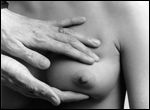Combination Hormone Therapy and Breast Tenderness Leads to Greater Risk of Breast Cancer
Is estrogen plus progestin better than estrogen alone for symptom relief in menopausal women? For women who have not had a hysterectomy, adding progestin to estrogen therapy counteracts the increased risk of uterine cancer from estrogen monotherapy. However, the progestin and estrogen combination increases breast cancer risk. The combination treatment also comes with its own side effects, including breast tenderness, which ranges from 8% to 15% of patients in randomized clinical trials.
Is estrogen plus progestin better than estrogen alone for symptom relief in menopausal women? For women who have not had a hysterectomy, adding progestin to estrogen therapy counteracts the increased risk of uterine cancer from estrogen monotherapy. However, the progestin and estrogen combination increases breast cancer risk. The combination treatment also comes with its own side effects, including breast tenderness, which ranges from 8% to 15% of patients in randomized clinical trials.

A new study published in Breast Cancer Research and Treatment asked about the significance of the biology underlying breast tenderness in women taking combination or estrogen hormonal monotherapy.[1] The trial authors, including first author Carolyn Crandall, professor of general internal medicine at UCLA’s Jonsson Comprehensive Cancer Center hypothesized that new-onset breast tenderness may be a clinical correlate of increasing mammographic density, which itself is a strong breast cancer risk factor. What they found is that women who developed new breast tenderness after starting combination hormone therapy had an increased risk of breast cancer while women on estrogen monotherapy with the same tenderness did not have a higher risk of the cancer. The increased risk in breast cancer for those on estrogen plus progestin therapy was 33%.
The current study analyzed data from the Women’s Health Initiative (WHI) Estrogen plus Progestin, and estrogen-alone clinical trials, which included 16,608 and 10,739, patients respectively. The WHI was launched in 1991 and has involved 161,808 healthy, postmenopausal women in clinical and observational studies.
A prior study showed that women who had new-onset breast tenderness during 12 months of combination therapy had greater mammographic density compared to women who did not have new breast tenderness. Another recent study, published last month, also by Crandall, found that women have a much higher frequency of breast tenderness, and change in breast density, when taking the combination hormone therapy than those who take estrogen monotherapy.[2] Various studies have also shown that higher breast density is associated with higher risk of breast cancer, around 4 to 6 times higher than women with breasts that are not dense, according to Crandall.
“The consistent theme we’ve run across throughout these studies is that estrogen and progestin compared to estrogen alone have a more marked effect on breast tissue,” Crandall said. “One theory is that there may be more growth of breast tissue, making the breasts more dense, when women take the combination therapy.”
The bottom line? Breast cancer is still quite rare in women taking hormone therapy. Approximately 8 additional women out of 10,000 who take combination estrogen plus progestin hormone therapy will develop breast cancer compared to the normal rate of incidence. However, women who develop new breast tenderness while on combination therapy should be aware that they may at an increased risk and should discuss this with their physician and be more vigilant about getting regular breast exams and mammograms.
Why women taking estrogen alone as menopausal therapy who had new breast tenderness did not have increased risk of breast cancer is not clear from this study but underscores the complexity of the biology of hormone influence on cancer development and should be followed up in new trials.
References
1. Crandall CJ, Aragaki AK, Cauley JA, et al. Breast tenderness and breast cancer risk in the estrogen plus progestin and estrogen-alone women's health initiative clinical trials. Breast Cancer Res Treat. 2011 Nov 1. [Epub ahead of print] PMID: 22042371
2. Crandall CJ, Aragaki AK, Cauley JA, et al. Breast tenderness after initiation of conjugated equine estrogens and mammographic density change. Breast Cancer Res Treat. 2011 Oct 7. [Epub ahead of print] PMID: 21979747